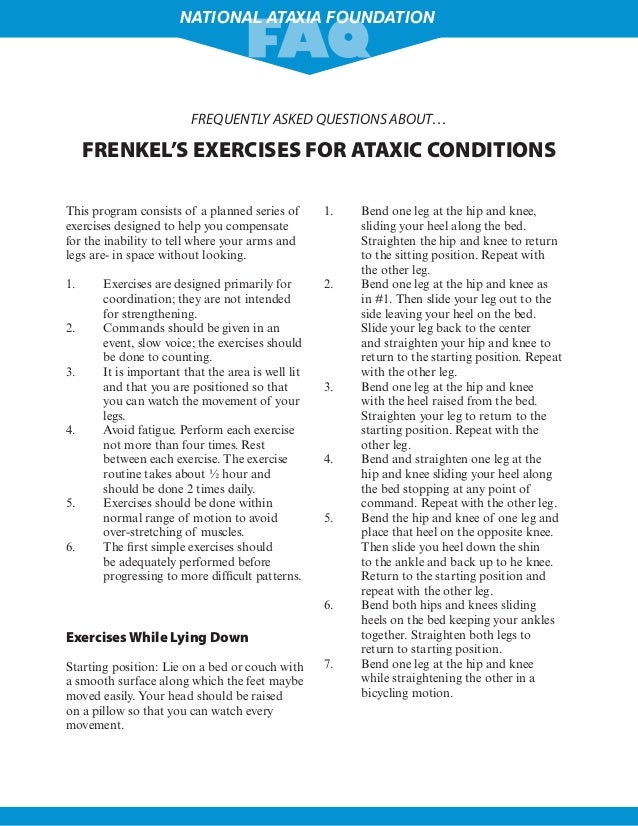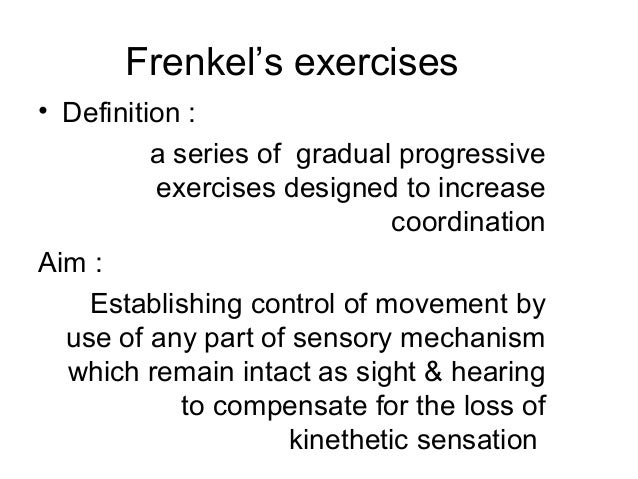
Frenkel Exercises are a series of motions of increasing difficulty performed by ataxic patients to facilitate the restoration of coordination. Frenkel's exercises are used to bring back the rhythmic, smooth and coordinated movements.
This exercise manual is a companion volume to Fiscal Policies and the World Economy: An Intertemporal Approach, Second Edition, by Jacob Frenkel and Assaf. This exercise manual is a companion volume to Fiscal Policies and the World Economy: An Intertemporal Approach, Second Edition, by Jacob Frenkel and Assaf Razin.
Dr. H S Frenkel was a physician from Switzerland who aimed at establishing voluntary control of movement by the use of any part of the sensory mechanism which remained intact, notably sight, sound and touch, to compensate for the loss of kinaesthetic sensation.
Frenkel Exercises were originally developed in 1889 to treat patients of tabes dorsalis and problems of sensory ataxia owing to loss of proprioception. These exercises have been applied in the treatment of individuals with ataxia, in particular cerebellar ataxia. The exercises are performed in supine, sitting, standing and walking. Each activity is performed slowly with the patient using vision to carefully guide correct movement. These exercises require a high degree of mental concentration and effort. For those patients with the prerequisite abilities, they may be helpful in regaining control of movement through cognitive compensation strategies. Patients with partial sensation can progress to practicing exercises with eyes closed. The main principles of Frenkel exercises are the following:

- Concentration or attention
- Precision
- Repetition
This program consists of a planned series of exercises designed to help patient compensate for the inability to tell where the arms and legs are- in space without looking.
- 1. Exercises are designed primarily for coordination; they are not intended for strengthening.
- 2. Commands should be given in an event, slow voice; the exercises should be done to counting.
- 3. It is important that the area is well lit and that patients are positioned so that they can watch the movement of their legs.
- 4. Avoid fatigue. Perform each exercise not more than four times. Rest between each exercise.
- 5. Exercises should be done within normal range of motion to avoid over-stretching of muscles.
- 6. The first simple exercises should be adequately performed before progressing to more difficult patterns.
General Instructions for frenkel exercises
Frenkel Exercise Manual Download
- Exercises can be performed with the part supported or unsupported, unilaterally or bilaterally.
- They should be practiced as smooth, timed movements, performed at a slow, even tempo by counting out loud.
- Consistency of performance is stressed and a specified target can be used to determine range.
- Four basic positions are used: lying, sitting, standing and walking.
- The exercises progress from postures of greatest stability (lying, sitting) to postures of greatest challenge (standing, walking).
- As voluntary control improves, the exercises progress to stopping and starting on command, increasing the range and performing the same exercises with eyes closed.
- Concentration and repetition are the keys to success.

Frenkel exercises for lower limb
Exercises for the legs in lying
- Flex and extend one leg by the heel sliding down a straight line on the table.
- Abduct and adduct hip smoothly with knee bent and heel on the table.
- Abduct and adduct leg with knee and hip extended by sliding the whole leg on the table.
- Flex and extend hip and knee with heel off the table.
- Flex and extend both the legs together with the heel sliding on the table.
- Flex one leg while extending the other.
- Flex and extend one leg while taking the other leg into abduction and adduction.
- Heel of one limb to opposite leg (toes, ankle, shin, patella).
- Heel of one limb to opposite knee, sliding down crest of tibia to ankle.
Whether the patient slides the heels or lifts it off the bed he has to touch it to the marks indicated by the patient on the plinth. The patient may also be told to place the heel of one leg on various points of the opposite leg under the guidance of the therapist.
Exercises for the legs in Sitting
Frenkel Exercise Manual Online
- One leg is stretched to slide the heel to a position indicated by a mark on the floor.
- The alternate leg is lifted to place the heel on the marked point.
- From stride sitting posture patient is asked to stand and then sit.
- Rise and sit with knees together.
- Sitting hip abduction and adduction.
Exercises for the legs in Standing
- In stride standing weight is transferred from one foot to other.
- Place foot forward and backward on a straight line.
- Walk along a winding strip.
- Walk between two parallel lines
- Walk sideways by placing feet on the marked point.
- Walk and turn around
- Walk and change direction to avoid obstacles.

Frenkel exercises for upper limb
Similar exercises can be devised for the upper limb wherein the patient may be directed to place the hand on the various points marked on the table or wall board to improve coordination of all the movements in the upper limb.
Some examples of Frankel exercises of upper limb in sitting position
- Have patient sit in front of a table and place a number of objects on the table. The patient then touches each object with the right hand and then the left hand.
- The patient flexes the right shoulder to 90 degree with elbow and wrist extended. The patient then takes his or her right index finger and touches the tip of his or her nose. This exercise is then repeated with the left hand. The exercise is performed alternating right and left index finger.
- The patient taps bilateral hands on bilateral thighs while alternating palmer and dorsal surfaces as fast as possible.
Certain diversional activities such as building with toy bricks or drawing on a black board, buttoning, combing, writing, typing are some of the activities that also improves the coordination.
Frenkel Exercises Handout
References
- Physical Rehabilitation by Susan O Sullivan
- Physiotherapy in Neuro-conditions by By Glady Samuel Raj
- Pocket Notes for the Physical Therapist Assistant- By Steven B. Skinner, Christina McVey
- Neurological Disabilities: Assessment and Treatment- By Susan E. Bennett, James L. Karnes
Recent Articles
|
Rating: 4.4 Votes: 252 |